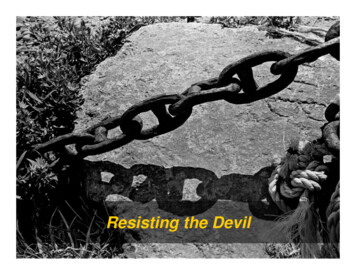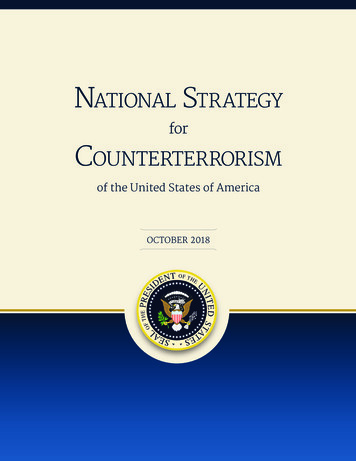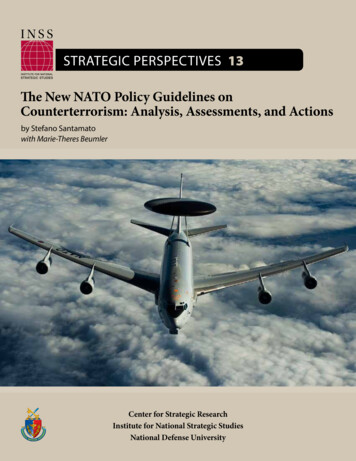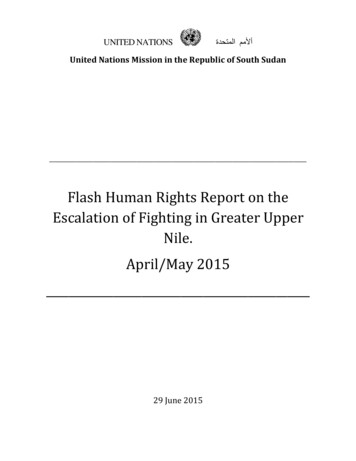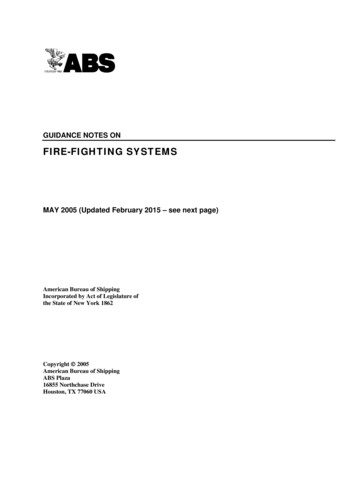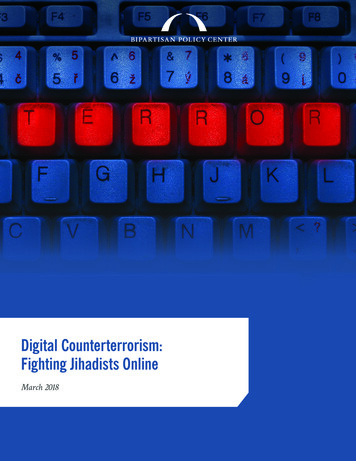
Transcription
Digital Counterterrorism:Fighting Jihadists OnlineMarch 2018
Task Force on Terrorism and IdeologyCo-ChairsGovernor Thomas H. KeanFormer Chairman, 9/11 Commission; Former Governor ofNew JerseyRepresentative Lee H. HamiltonFormer Vice Chairman, 9/11 Commission; Former Representativefrom IndianaStaffBlaise MisztalMichael HurleyNicholas DanforthJessica MichekDirector of National SecuritySenior Policy AnalystContributorPolicy AnalystDISCLAIMERThis paper was written by staff at the Bipartisan Policy Center. The findings do not necessarily represent the views of the members of theTask Force on Terrorism and Ideology. In addition, the findings and recommendations expressed herein do not necessarily represent theviews or opinions of BPC’s founders or its board of directors.1bipartisanpolicy.org
Table of Contents42Introduction55810Social MediaTerrorists’ Use of Social MediaCounter-MessagingRemoving Jihadist Messages15151618EncryptionStrong Encryption Since the Snowden LeaksTerrorists’ Use of Encrypted CommunicationsAddressing the Encryption Challenge20Implications for Policymakers26Conclusion27Appendix A30Endnotesbipartisanpolicy.org
IntroductionMohammed Yazdani seemed to be on the path to success. As The New York Times reported, despite being born in a poor area ofHyderabad, India, he had earned an engineering degree and landed a job in Saudi Arabia, where he worked for four years.1 During his timeabroad, Yazdani was captivated by the Islamic State’s lightning-quick military advance and sophisticated online propaganda. Inspired tojoin the caliphate, he “logged onto Twitter and searched the hashtags #ISIS and #Khilafa,” quickly making contact with an Islamic State(also known as ISIS) recruiter. The conversation then hopped over to Telegram, an encrypted messaging service. Using Telegram and otherencrypted messaging applications, ISIS planners helped Yazdani recruit conspirators, locate weapons caches that had been prepositionedaround India, swear allegiance to ISIS, and attempt to manufacture explosives.“It is impossible to conclude that the enemy has been defeated.Rather, the threat of terrorism has metastasized.”Fortunately, Indian police rolled up the new cell before it could strike. The case nevertheless illustrates how new technologies havedramatically expanded terrorist groups’ global reach. Social media allows terrorist groups to distribute propaganda—including slicklyproduced videos and Instagram-ready photo streams—and to recruit potential followers instantly, at no cost, anywhere in the world.Encrypted messaging applications provide no-cost global communications secured by virtually unbreakable cryptography—a level ofsecure communications previously available only to the most advanced states. In the battle against jihadist terrorism, the digital world isthe new ungoverned territory. To prevail, governments will have to deny jihadists the ability to operate securely in these digital realms.bipartisanpolicy.org3
Social MediaSocial networks are less than two decades old, yet it is nooverstatement to say that they have already reshaped manyaspects of modern life. No earlier medium combined such avast audience with social media’s personalized experience,tailored by sophisticated algorithms to each user’sinterests—or, skeptics would argue, to each user’s cognitivesusceptibilities. That social media can influence and evendrive world events is now beyond dispute. The 2016 U.S.presidential election is one of many examples: The Trumpcampaign, despite its lower budget, deftly used Facebook andother social-media tools to reach voters with micro-targeted,personalized messages. “Ineffective ads were killed inminutes, while successful ones scaled. The campaign wassending more than 100,000 uniquely tweaked ads to targetedvoters each day.”2 Meanwhile, entities linked to the Russiangovernment ran “scores” of paid ads on Facebook and Twitter;the polarizing ads, which appealed to both the left and right,reached hundreds of thousands, if not millions, of Americans.3Terrorists’ Use of Social MediaTerrorists have always adapted new technologies to theirpurposes, and social media is no exception. Indeed, socialmedia has proved particularly well-suited for terroristpropagandizing and recruiting for several reasons.“Social media has proved particularly wellsuited for terrorist propagandizing andrecruiting for several reasons.”First, social media enables terrorists to communicateradicalizing messages to a far wider circle of potentialadherents than they could have reached with traditional4media. Previously, radicalization required personal contactwith someone who could provide materials, ideologicalgrooming, and connections to wider jihadist networks.Decades ago, when the global jihadist movement was in itsinfancy, the followers of radical clerics circulated theirsermons on audiotapes, reproduced one at a time and passedfrom one follower to another. Desperate to reach a wideraudience from his bases in Sudan and Afghanistan, Osamabin Laden faxed his diatribes and fatwas to media outlets inLondon.4 Today, social-media platforms like Twitter,Instagram, Facebook, and YouTube offer the ability toinstantaneously convey one’s message to users around theworld, often in the form of captivating images or video. What’smore, unlike hosted websites, which one might argue alsooffer global reach, these services are free, user-friendly, andmost can be used pseudonymously. While terrorists have usedpassword-protected forums since the beginning of the internetage, the pool of potential recruits, supporters, or sympathizersthat can be reached on social media is vastly larger than thepool of potential visitors to a password-protected forum. Assenior Homeland Security Department official Robin Taylornoted in recent testimony, “The reach and popularity of socialmedia has enabled HVEs [homegrown violent extremists] toconnect more easily with terrorist organizations, such asISIS.”5 A senior FBI official echoed that concern: “Through theinternet, terrorists overseas now have access into our localcommunities to target and recruit our citizens and spread themessage of radicalization to violence faster than we imaginedjust a few years ago.”6 Put simply, social media allowsterrorists to recruit and propagandize across borders, in a waythat 20th-century technology never allowed.bipartisanpolicy.org
Another salient feature of social media, less obvious but highlyrelevant for terrorists, is that on social-media platforms allcontent looks more or less the same. With modest exceptions(Twitter’s blue check mark, for example), content posted to asocial-media platform by a veteran investigative journalist ora Harvard-trained physicist bears the same visual indicia ofreliability as content posted by a fringe conspiracy theorist. Onsocial media, there are no editorial gatekeepers, nor is cost abarrier to entry.Another advantage of social media is that it enables terroristsympathizers to engage directly, and publicly, with morecredible figures, hijacking those figures’ visibility to amplifythe terrorists’ own messages. Sometimes this means riding inthe wake of a more-prominent user’s messages, a nowfamiliar tactic for social-media self-promotion; “being the firstto reply to a Trump tweet,” for example, “promises someonean enormous audience.”12 But it can also entail baiting,debating, or harassing more prominent figures, to gainprominence or to win plaudits from like-minded users.Instead, production value serves as the most readily available Terrorist propagandists have capitalized on this aspect ofindicator of quality, and terrorists have grown adept at usingsocial media, eagerly trading rhetorical salvos with U.S.desktop software to turn out propaganda materials that are as government accounts. For example, the State Department’spolished as traditional media. An analysis of Americanwidely derided “Think Again Turn Away” Twitter accountjihadists by the Program on Extremism at George Washington traded snarky jabs with ISIS sympathizers, inadvertentlyUniversity found, “Two features that seemed to distinguish the “providing jihadists legitimacy and a stage on which to projectmedia operations of IS [Islamic State] from previous jihadisttheir messages.”13 Since 2015, the State Department’sorganizations’ material was their professional-qualitycounter-narrative strategy has shifted “away from the earlier,productions and their ability to disseminate this content‘snarky’ tone and toward a fact-based message.”14 But thethrough social media.”7 As one researcher found, based on 30 program remains emblematic of the risks and unintendeddays of following ISIS propaganda at the height of its pseudo- consequences of counter-messaging campaigns in the era ofcaliphate: “In just 30 days, IS’s official propagandists created social media, a decentralized ecosystem in which lumberingand disseminated 1,146 separate units of propaganda. Photo bureaucracies have frequently been bested by leaderlessessays, videos, audio statements, radio bulletins, text round- swarms of like-minded individuals.ups, magazines, posters, pamphlets, theological treatises, [r]adio bulletins and text round-ups were released in sixThe final reason why social media is such an effectivelanguages. All of it was uniformly presented and incredibly amplifier for terrorists is the power with which platforms’well-executed, down to the finest details.”8 Much of thisalgorithms connect users to content that resonates with theirmaterial is designed to influence young men of primeexisting inclinations and preferences. Columbia Universityrecruiting age, for whom social media is the most importantProfessor Tim Wu has dubbed the internet giants that control9information source. Meanwhile, the “multi-lingual approachthe major social-media platforms “attention merchants”; likeIS implements” in its propaganda has another “clearnewspapers and television networks before them, their10objective: targeting non-Arabic speaking potential recruits.”business models depend on selling advertising, which meansThis seems to have worked. Danish researchers found “thatthat their profits depend on attracting as much of users’the foreign fighter flow to Syria [was] younger than for pastscarce attention as possible. Social-media platforms possessconflicts, with typical recruits being between 16 and 25 years two assets that enable them to capture attention moreold—a prime social media age.”11durably than any prior medium: reams of detailed, personalinformation about their users’ preferences, and algorithmsbipartisanpolicy.org5
that analyze that data to determine what the user wants tosee, read, or buy. This enables them to tailor the content theuser sees in order to keep the user glued to the platform. Thenews that Facebook users see in their news feed “ispersonalized based on past clicks,” including the “like” button,and on an items’ popularity among other users with similarpreferences.15 Similarly, Google sorts and filters search resultsbased on the user’s “location and previous searches andclicks.”16 Engineers working on YouTube’s recommendationengine, which determines which videos a user will see in the“up next” column, “continuously experiment[ed] with newformulas that would increase advertising revenues byextending the amount of time people watched videos.”17 Theresult, according to sociologist and technology expert ZeynepTufekci, is that “the videos recommended and auto-played byYouTube get more and more bizarre or hateful.”18 Ensconced ina “filter bubble” created by algorithms designed to give theuser what he or she wants, a user may rarely, if ever,encounter any opinion with which he or she disagrees. Indeed,this effect tends to become more pronounced over time: Asthe platforms acquire more information about the user’s exactpreferences, the algorithms become progressively better atanticipating the user’s desires.facts, and encouragement to act, all of which point in the samedirection. The difference is that analog-era radicalizationrequired direct contact with a tutor who would personally leadthe recruit down the intellectual and emotional path away frompast associations and beliefs and toward radicalism. Forexample, as al Qaeda’s message began to spread in the late1990s and early 2000s, mainstream Islamic leaders andcounterterrorism officials feared that radicalization wasoccurring in intimate “storefront” mosques, often beyond thecontrol of established Islamic authorities, where young men fellunder the influence of a charismatic radical preacher. Ironically,in 2000, Dar Al-Hijrah, a large mosque in Northern Virginia,hired future terrorist recruiter Anwar Awlaki as an imam to lureyoung men away from such a storefront mosque, Dar AlArqam.20 Osama bin Laden was groomed by a MuslimBrotherhood-affiliated teacher at the school he attended as aboy in Saudi Arabia.21 Social media creates a similar intellectualand emotional climate, enabling radicalization without the needfor direct personal contact. As such, it dramatically expands theset of young Muslims vulnerable to radicalization; anyone withan internet connection can now receive the jihadists’ call.Social media has also given sympathizers a new way tosupport jihadist causes without committing or financingThe result is that the sharpest-edged, least-nuanced content,attacks themselves. This new class of “virtual [terrorist]which tends to be the most emotionally resonant, is also theentrepreneurs,” as Seamus Hughes and Alexander Meleagroumost widely disseminated. Illustrative Facebook news feedsHitchens have described them, have “acted in a more auxiliaryproduced by this approach look less like traditional newspapers capacity, plugging their Western contacts into wider extremistand more like “red” and “blue” propaganda channels, as amilieus (both online and offline) and encouraging extremerecent Wall Street Journal feature illustrated.19 Users becomebeliefs, while offering suggestions and options forenmeshed in feedback loops that confirm, and thereforemobilization.”22 Sometimes the assistance extends to thestrengthen, their preexisting beliefs about the world—theirdirect planning of an attack, but often “encouragement,hatreds, their fears, their preferred accounts of the causes ofreassurance, and comradery” is all a potential terrorist needs.their grievances, and their sense of what is to be done.Hughes and Hitchens describe an extensive U.S.-basednetwork of such virtual entrepreneurs, who were linked to ISISTo be sure, the process of radicalization in online echo chambers propagandists and planners in Syria. Jalil ibn Ameer Aziz “wasresembles radicalization in any other closed environment: Theheavily involved in online extremist networks, creating at leastvulnerable mind is fed a steady diet of narrative, cherry-picked 57 pro-Islamic-State Twitter accounts.”23 When he was6bipartisanpolicy.org
arrested, authorities found a stash of high-capacitymagazines and ammunition in his home in Pennsylvania. Azizserved as a node connecting Junaid Hussain, a notoriousonline propagandist and recruiter based in Syria, withAmericans interested in carrying out attacks on behalf of theIslamic State. Safya Yassin, a Missouri woman, used at least97 Twitter accounts to spread ISIS propaganda; she eventweeted the names and addresses of three federalemployees under the words “Wanted to Kill.”24 EltonSimpson, one of the two men who attacked a free-speechevent in Garland, Texas, in 2015, “had been in direct contactwith at least two virtual entrepreneurs using Twitter directmessage and SureSpot,” an encrypted messagingapplication.25 With social media as a meeting place, it iseasy for curious and disaffected young people to connectwith such online facilitators. These facilitators, in turn, areoften only one step removed from operational terrorists,who, if needed, can provide the specific direction or knowhow to execute an attack.But while social media offers terrorists valuable capabilities,it also brings vulnerabilities. Foreign fighters’ ostentatious useof social media in Syria—documenting their violent exploitslike a grisly reality show—helped inspire new recruits totravel to the pseudo-caliphate, but it also handed reams ofopen-source materials to Western intelligence services. Asmany millennial job applicants have found out, personaldetails posted on social media can be discovered by anyone,to the user’s detriment. Foreign-fighters’ selfies and socialmedia bragging may have drawn new recruits, but theaccounts also gradually “[went] silent, presumably as theirowners [we]re killed,” many in U.S. airstrikes.26 Information inthe posts helped intelligence agencies and other analysts tolocate individual terrorists, observe how terrorist groupsoperated in Syria, and learn how foreign fighters traveled fromEurope to Syria. Private messages sent on these platforms werevulnerable to surveillance by Western officials—leadingterrorist groups to shift most of their communications tobipartisanpolicy.orgencrypted platforms, a trend discussed later in this report.Social networks provide a detailed map of who is linked towhom in a given organization or movement—a basic task ofintelligence analysts seeking to understand a terrorist group.And if the first stages of recruiting take place on a publiclyvisible forum, counterterrorism operatives have an opportunityto identify potential recruits in real time and either divert themaway from terrorism or recruit them as potential double-agents.Counter-MessagingGovernments were initially caught off guard by the IslamicState’s sophisticated social-media campaign, but they quicklybegan to contest this virtual terrain. One element ofgovernments’ response has been counter-messaging:attempting to refute or undercut the messages propagated byterrorist groups and their sympathizers. Those efforts, whilelaudable in theory, have struggled in practice. More recently,governments and the social-media platforms themselves haveshifted their focus away from competing with terrorists in themarketplace of ideas and toward denying terrorists the abilityto use prominent platforms for recruiting and propaganda.In the wake of the Islamic State’s blistering ascent, the StateDepartment’s Center for Strategic CounterterrorismCommunications (CSCC) began to aggressively challenge ISISand its sympathizers and amplifiers on social media.27 Thecenter’s aim, explained then-head Ambassador AlbertoFernandez, was “not to make people love the U.S.,” but “tomake al-Qaeda look bad.”28 That approach was informed bythe Bush administration’s experience attempting to boost thepositive image of the United States in the Middle East usingsuch traditional news media as radio and television. TheU.S.-created broadcasters Al Hurra TV and Radio Sawa wereintended to “improve America’s image in the Middle East,” but“a 2006 study of university students in five Arab countries found their attitude toward U.S. foreign policy worsened aftertuning into the channels.”29 Given that experience, it made7
sense to pursue a “negative” campaign focused on bringingdown the Islamic State’s favorability, rather than quixoticallyseeking to persuade committed or potential Islamic radicals tofavor the United States.Unfortunately, the CSCC’s direct online engagement withterrorist groups and their sympathizers had unintended andunhelpful effects. By directly debating previously obscurejihadist sympathizers, the U.S. government inadvertentlyelevated their status, allowing them to build their credibility bydirectly confronting the hated enemy. Conversely, criticsbelieved that some of the CSCC’s activities eroded theprestige of the U.S. government. Trading snarky, juvenile jabson Twitter with jihadist nobodies was beneath the dignity ofthe State Department. What’s more, posting grisly videos thatincorporated brutal ISIS propaganda, like the CSCC’s infamous“Welcome to ISIS Land” montage, raised ethical concerns.30 In2016, the CSCC’s responsibilities were transferred to a new,interagency “Global Engagement Center” (GEC) also housed atthe State Department. The GEC has used social media tomicro-target users vulnerable to radicalization, but expertshave questioned its effectiveness.31 More recently, the GEChas stalled under the Trump administration; the GEC is acasualty of doubts about its value and disputes about Russianpropaganda and its effect on the 2016 election.32the program aspired to persuade. Operators also lackedadequate knowledge of sectarian or local variations in Islamicpractice and the language used to describe it. By contrast, thejihadists and sympathizers with whom they were debatingwere adept at deploying religious doctrines and attuned to thelinguistic and cultural subtleties that tripped up the U.S.based contractors. As the Associated Press put it, “Engagingin theological discussions on social media with people who arewell versed in the Quran is not for beginners.”34This speaks to a broader challenge in post-9/11 efforts tocounter Islamist ideology: Western governments’ lack offluency in the languages, ideas, traditions, history, and moresof the Islamic world. In the Cold War, the battle of ideas wasfought largely within the West, between economic andgovernmental systems that were both the products of Westernthought. In the struggle against Islamist terrorism, thearguments that move public opinion draw upon traditions thatfew Americans understand, often expressed in languages thatfew Americans have mastered.These epistemic limitations are especially problematic forcounter-messaging operations that take place on socialmedia. Verbal combat on Twitter calls for the quick stings of ayellow jacket, not the cautiously aimed salvos of an artillerist.There is no time to pause to consult an expert. And becauseCounter-messaging efforts outside the State Department have the volume of jihadist messages is so huge, it takes a swarmbeen even less successful. WebOps, a Defense Departmentof yellow jackets, not just a few. Yet precious few Americansprogram created to thwart ISIS propaganda and dissuadehave the cultural, linguistic, and religious fluency to beat apotential recruits, was an expensive fiasco. Programjihadist sympathizer on these terms. Ideally, these few wouldemployees described to the Associated Press “multiplehave been recruited into higher-value intelligence andexamples of civilian Arabic specialists who have littlecounterterrorism work than tweeting snark at jihadist fanboys.experience in counter-propaganda, cannot speak Arabicfluently and have so little understanding of Islam they are noAnother defect in U.S. approaches to countering ISIS33match for the Islamic State’s online recruiters.” Translatorsmessages is that ISIS, in contrast to al Qaeda, has been lessrepeatedly confused the Arabic words for “authority” andconcerned with building support and consent among Muslim“salad,” referring to the Palestinian Authority as thepopulations. As terrorism expert William McCants explained,“Palestinian salad,” eliciting ridicule from the very audienceISIS’s strategy is to use fear and violence to cow populations8bipartisanpolicy.org
into submission, not to win hearts and minds.35 For thatreason, highlighting ISIS’s violence against other Muslims, asthe State Department did in YouTube videos like “Welcome toISIS Land,” did not necessarily undermine the Islamic State’smessage among its target audiences: young men, whom ithoped to recruit, and local populations, whom it hoped tointimidate. In the words of McCants: “When we advertise theIslamic State’s brutality, the Islamic State loves it.”36 This maychange, however, with the collapse of the Islamic State’sterritorial caliphate. Now that ISIS has reverted from aquasi-state, which can command and extract resources fromits population through terror, back to being a clandestineinsurgency, a reputation for brutality to fellow Muslims maybecome a liability rather than an asset.A final downside of a focus on counter-messaging is thatsalvos of saucy social-media messages—as if Twitter andFacebook were themselves fields of battle—obscured theunderlying factors that drove some Muslims to support theIslamic State’s messaging and most others to ignore oroppose it. To be sure, the channels of communication andpersuasion are important, but it is the underlying content ofthe messages and the receptiveness of those who see themthat ultimately determine whether and how the recipients act.As former CSCC Chief Richard LeBaron put it, “We counttweets and forget that they are just tweets—they are not avery good indicator of ISIS recruiting abilities.” He argued:On the other hand, it may be that America’s ability to influencethe underlying “motivations” that compel individuals to actionare very constrained, and that online counter-messagingoperations directed at the small number of “people on thecusp of radicalization who live in a constructed world ofconspiracy and isolation” are thus a reasonable, costeffective, relatively low-risk way to target that decisive group.And to be fair to the CSCC, and other U.S. government entitiesthat have undertaken counter-messaging efforts in socialmedia, this discipline is still in its infancy. Finding viableformulas for counter-messaging, particularly in the uniqueenvironment of social media, will take trial and error, whichmeans that some flops are inevitable.Removing Jihadist MessagesAlternatively, it may be that the primary lesson of thesestruggles is that counter-messaging is not the right way toprevent terrorists from exploiting social media; instead,denying them that forum outright may be more effective. Thatseems to be the lesson Western governments have drawn. Inrecent years, attention has shifted to removing terroristcontent from social-media platforms, rather than seekingmerely to debunk or discredit it.Because “terrorist content” is often political speech, thisraises constitutional concerns. European countries’constitutions give them substantial latitude to prohibit speechSocial media provides access to a large audience but itwhere doing so advances social cohesion. Germany andrarely is an independent force that mobilizes an individual France, for example, have long criminalized Holocaust denialto take off for the Turkish border. Otherwise there would be and Mein Kampf only recently went back on sale in Germanya lot more recruits. Motivations for taking the step fromafter being banned for decades.38 European governments havesympathy for a cause to individual action are varied:also used prohibitions against “hate speech” or “incitement”personal circumstances of social isolation, resentment into criminalize speech that maligns recent immigrants orone form or another, the urge to “do something” in thereligious or ethnic minorities.face of persecution of fellow Muslims, the lack of otherthings to do, and political marginalization. The motivationof a former Iraqi army major is quite different from that ofa teenager from Wales.37bipartisanpolicy.orgGiven these more permissive constitutional frameworks,European nations have more latitude than the United States inmandating that social-media platforms remove jihadist9
speech. The most notable new effort in that vein is Germany’s2017 Netzwerkdurchsetzungsgesetz (NetzDG), which requirescompanies to take down “hate speech,” including terroristspeech, within 24 hours in the case of “obviously illegal” speechand seven days in closer cases.39 Facebook “now has more than1,200 people based in Germany helping it to check content, partof a global team it has rapidly expanded to around 7,500.”40 InJune 2017, France and the United Kingdom jointly announced thatthey are “exploring the possibility of creating a new legal liabilityfor tech companies if they fail to remove content,” including“penalties such as fines for companies that fail to take action.”41In the United States, by contrast, the First Amendment to theConstitution provides that “Congress shall make no law abridging the freedom of speech,” and the U.S. Supreme Courthas consistently held that this includes speech that offends,insults, or foments hatred. As relevant here, even speech thatadvocates the use of force, lawbreaking, or the overthrow of thegovernment is protected, “except where such advocacy isdirected to inciting or producing imminent lawless action and islikely to incite or produce such action.”42 And while much jihadispeech surely is directed to “producing imminent lawless action,”other constraints make it difficult for the government to legislateprospectively to effectively target that speech. For example,courts will not permit the government to enforce criminal lawsthat are unconstitutionally vague, fail to provide fair notice ofwhat is criminal, or are “overbroad” in that they would bar asubstantial amount of constitutionally protected speech inaddition to unprotected speech.43 Requiring companies to screenmessages for illegal content before publishing them would beeven more fraught: “Prior restraints” banning publication outrightare even more constitutionally disfavored than after-the-factpunishments for prohibited statements.44Nonetheless, some legal experts have floated theories that wouldallow social-media companies to be held liable for permittingjihadist content on their platforms. The families of victims ofseveral terrorist attacks have sued social-media companies,10arguing that the companies provided “material support” bypermitting terrorists to use their platforms. The plaintiffs alsoclaim, with support from some legal experts, that Section 230of the Communications Decency Act, which shields internetplatforms from liability for user-created content, should notapply to the act of knowingly permitting terrorist groups tomaintain accounts.45 Thus far, however, Section 230 has beenheld to bar these suits.46A more promising vein of progress, in both the United Statesand Europe, is voluntary cooperation by social-mediacompanies to remove extre
counter-narrative strategy has shifted “away from the earlier, ‘snarky’ tone and toward a fact-based message.”14 But the program remains emblematic of the risks and unintended consequences of counter-messaging campaigns in the era of s
